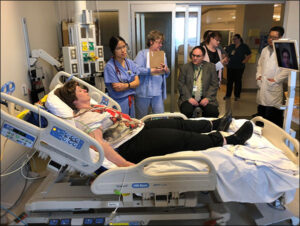Effort Shown to Significantly Reduce Unnecessary Hospital Transfers

VA Emergency Department staff and simulation trainers participate in the Telestroke Program go-live training at the Las Vegas VAMC in 2018. VA photo
BIRMINGHAM, AL — Prompt access to specialized care is critical to limiting the damage caused by a stroke. Since 2018, the VHA National Telestroke Program (NTSP) has made speedy, expert stroke care available to patients even at rural facilities with limited staffing using technology.
Through a mobile device, a neurologist from the central hub is able to evaluate patients and either provide a treatment plan for the on-site staff to carry out or recommend—in consultation with the treating staff—transfer to a hospital with a higher level of care, such as a comprehensive stroke care center.
As of a report last August, VA’s telestroke program offered services at 52 VA medical centers and employed a team of 27 physicians who specialize in vascular neurology. Since the program started in 2017, it has provided care to more than 5,000 veterans.
Telestroke networks, as a whole, have been associated with improved outcomes and greater access to care; however, findings from other systems don’t necessarily translate to the VHA model, said Michael J. Lyerly, MD, physician lead of the UAB eMedicine Telestroke Program, director of the Birmingham, AL, VAMC Stroke Center and author of a new study assessing the VHA National Telestroke Program. “Other networks are hub-and-spoke models, with the network seeing patients within the region and transferring patients within their own network to another hospital. The VA is different, because the VA is not going to be sending patients from one VA to another VA for escalation of care. Typically, they are going to be sending patients outside the VA system to a community stroke primary stroke center or a comprehensive stroke center if the patient requires a higher level of care,” Lyerly explained.
“What we wanted to focus on is what impact is our telemedicine program having on how patients are transferred outside of the VA,” he added. “The goal was trying to determine are we seeing increases in transfers, which might indicate that we are seeing patients who are higher acuity we are trying to match with a higher level of services, or, on the flip side of the coin, are we seeing more patients who are able to stay, possibly due to the fact that the telehealth service is identifying patients who may not require higher levels of care or maybe having what we call a mimic stroke, so they are not actually having a stroke, but they are having symptoms that look like a stroke, and they may not need a higher level of care.”
The researchers analyzed 3,488 stroke encounters (1,056 prior to the implementation of NTSP and 2,432 after its implementation) with patients presenting to the emergency departments of 21 VA hospitals. Transfer rates were determined through a review of administrative data and chart review. Patient- and facility-level characteristics were collected to identify predictors of transfer. Comparisons were made using the test, Wilcoxon rank sum, and χ2 analysis. Multivariable logistic regression with sensitivity analysis was conducted to assess the influence of telestroke implementation on transfer rates.1
Decrease in Transfers
Following implementation, the researchers observed an absolute 14.4% decrease in transfers across all levels of stroke center designation. Younger age, higher stroke severity and shorter duration from symptom onset were associated with transfer.
“We found that hospitals that saw fewer stroke patients each year were more likely to transfer, which probably indicates that, with lower levels of general stroke patients, the staff may not be as comfortable taking care of stroke patients or may not have the resources to take care of a stroke patient, so they are more likely to transfer,” Lyerly said.
“Every increase in 10 stroke encounters seen in the emergency room at a facility each year resulted in about a 15% decrease in the likelihood that a patient would be transferred,” he pointed out. “So essentially, the more patients with stroke a hospital was seeing on an annual basis, the more likely they were to keep a patient because they were likely more comfortable with the patient population.”
At the patient level, the researchers found that, in general, younger patients and patients with more severe strokes were more likely to be transferred. Lyerly suggested the reason might that younger patients have more severe strokes or have strokes for less typical reasons, so the treating facility would want the patient under the care of a vascular specialist. “People with more severe strokes may have increased need for therapies and resources, such as neurocritical care monitoring,” he said.
“The most striking finding, after adjusting for patient- and facility-level characteristics, was that, after the implementation of the telestroke program, veterans presenting with symptoms of stroke were 60% less likely to need to be transferred out of the VA” Lyerly said. “So that told us the telestroke program is providing a lot of value for patients to be able to match them more correctly to resources that they need, and many times they would not need to be transferred out of the VA. It clearly added value for the hospitals and the VA health system as a whole.”
- Lyerly MJ, Daggy J, LaPradd M, Martin H, Edwards B, Graham G, Martini S, Anderson J, Williams LS. Impact of Telestroke Implementation on Emergency Department Transfer Rate. Neurology. 2022 Apr 19;98(16):e1617-e1625. doi: 10.1212/WNL.0000000000200143. Epub 2022 Feb 28. PMID: 35228338.

